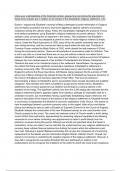Essay
Using your understanding of the historical context, assess how convincing the arguments in these three extracts are in relation to the impact of the Elizabethan religious settlement
30 mark source based essay question for the breadth study of the Tudors for AQA history A Level on the Religious Settlement. Level 5/A* response.
[Show more]



